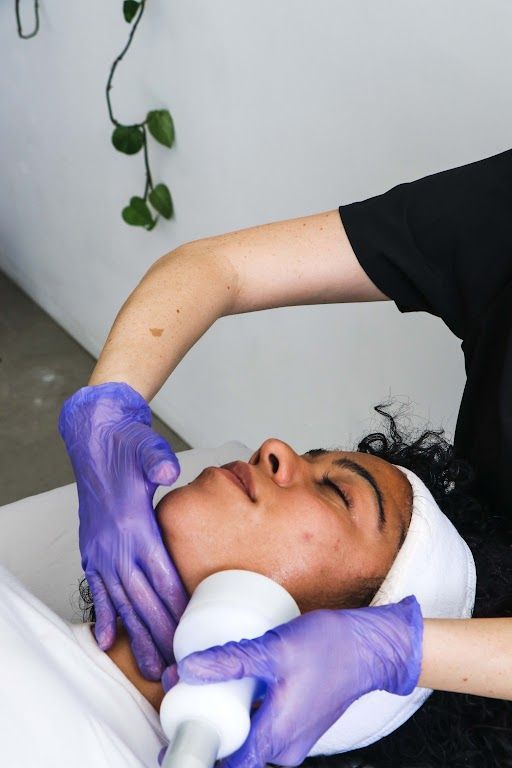Transform Your Skin: 5 Acne-Fighting Facial Techniques for Stunning Results

Acne-fighting facials can help you achieve clear and healthy skin. These treatments target the main causes of acne and leave your skin looking fresh. Understanding what these facials involve can help you decide if they are right for you.
Key takeaways
- Acne-fighting facials focus on deep cleansing and treating breakouts.
- They often include extractions, exfoliation, and masks.
- Regular treatments can lead to clearer skin and improved confidence.
- Choosing a qualified esthetician is important for safe and effective results.
- Explore related treatments that enhance skin health and beauty.
What are acne-fighting facials?
Acne-fighting facials are special skin treatments. These services are designed to clear up acne and improve skin health. They can help with many skin issues like clogged pores, excess oil, and inflammation. Each facial is unique and tailored to meet your needs.
How do these facials work?
During an acne facial, a trained esthetician will use different products and techniques. They may cleanse your skin, apply steam, or use special masks. The goal is to remove dirt, oil, and dead skin cells that can cause breakouts. This process helps to calm your skin and reduce redness.
Types of Acne-Fighting Facials
Type of Facial Key Features Recommended For Chemical Peels Exfoliates with acids; reduces blemishes Oily or acne-prone skin LED Light Therapy Uses light to kill bacteria and reduce inflammation Persistent acne Hydrofacial Deep cleansing with hydration All skin types for hydration AHA/BHA Facials Alpha/Beta Hydroxy Acid focus to clear pores Clogged pores and blackheads The steps of an acne-fighting facial
Step 1: Consultation
Before your facial begins, the esthetician will talk to you about your skin. They will ask questions about your skin type and any concerns you have. This helps them create a plan that works best for you.
Step 2: Deep cleansing
The first step in the facial is a deep cleanse. This removes makeup, dirt, and oil from your skin. The esthetician will use a gentle cleanser suitable for acne-prone skin. This step is critical for preparing your skin for the next stages of the treatment.
Step 3: Steam treatment
Next, the esthetician may use steam. This helps open up your pores. Opening your pores makes it easier to remove impurities. It also helps loosen any debris that might cause breakouts.
Step 4: Exfoliation
Exfoliation is the next step. The esthetician will gently scrub your skin, helping to remove dead skin cells. This process can prevent clogged pores and reduce the chance of new acne forming. They may use a scrub, chemical peel, or specialized tool for this.
Step 5: Blemish extractions
If you have any blemishes or blackheads, the esthetician might perform extractions. This means they will carefully remove these blemishes without damaging your skin. Extractions should always be done by a professional to avoid scarring or infection.
Step 6: Application of a mask
After cleaning your skin, a soothing mask will be applied. This mask is designed to calm your skin and reduce redness. It can also provide hydration, which is important for healing. Many masks have ingredients like tea tree oil or salicylic acid, known to fight acne.
Step 7: Toner or astringent
Once the mask is removed, a toner or astringent may be applied. This helps to tighten your pores and balance your skin’s pH. Using the right toner can also help prevent future breakouts.
Step 8: Moisturizer and sun protection
Finally, the esthetician will apply a moisturizer that suits your skin type. Even if you have oily skin, moisturizing is essential. A good moisturizer helps keep your skin hydrated. They may also add sunscreen for protection against UV rays.
Why are these facials important?
Acne-fighting facials are essential for clear skin. They provide a deep clean that you can’t achieve with regular washing at home. Regular treatments can help you maintain healthy skin and avoid breakouts.
Benefits of acne-fighting facials
- Deep cleaning: They remove impurities and excess oil.
- Reduced inflammation: Facials can calm red and irritated skin.
- Customized care: Treatments are tailored to your specific skin needs.
- Improved product absorption: After a facial, your skin can absorb skincare products better.
- Boost in confidence: Clear skin can help you feel better about yourself.
Considerations for Choosing a Treatment
- Assess your skin type before choosing a facial.
- Discuss any allergies or sensitivities with your esthetician.
- Consider treatments that complement your skincare routine.
How often should you get acne facials?
For the best results, consider scheduling a facial every four to six weeks. This timing allows your skin to heal and adjust between treatments. However, your esthetician may suggest a different schedule based on your skin’s needs.
Choosing the right esthetician
When looking for an esthetician, choose someone with experience in treating acne. Look for reviews or ask friends for recommendations. A qualified professional will help you achieve the best results for your skin.
What to expect at your appointment
During your appointment, you may feel relaxed and pampered. The treatment can take anywhere from 60 to 90 minutes. You might feel some tingling during the facial, especially during exfoliation. However, it should not be painful.
Aftercare tips
After your facial, your skin might be sensitive. Here are some tips to help keep your skin healthy:
- Avoid direct sunlight for a few days.
- Use gentle products on your skin.
- Don’t pick or squeeze blemishes.
- Stay hydrated by drinking plenty of water.
- Follow the skincare routine your esthetician recommends.
Common ingredients used in acne-fighting facials
Knowing the ingredients in your facial can help you understand their benefits. Here are some common ones:
Salicylic acid
This ingredient helps to exfoliate the skin and remove dead cells. It also deeply penetrates pores to help clear up acne.
Benzoyl peroxide
Often used for its antibacterial properties, benzoyl peroxide can kill acne-causing bacteria and reduce inflammation.
Tea tree oil
Known for its natural antibacterial effects, tea tree oil helps to soothe the skin and fight breakouts.
Clay
Clay masks can absorb excess oil and draw out impurities from the skin. They help to keep your pores clean.
DIY acne-fighting facial techniques
If you can’t visit a spa, you might consider a DIY facial at home. Here are a few steps you can take:
- Cleanse your face: Use a gentle cleanser to remove dirt and oil.
- Steam your face: Hold your face over a bowl of hot water for a few minutes.
- Exfoliate: Use a gentle scrub or a homemade sugar scrub.
- Mask: Apply a clay mask or a mixture of honey and lemon.
- Moisturize: Use a light moisturizer that suits your skin type.
When to seek professional help
If home remedies and over-the-counter products are not working, it’s time to see a professional. An esthetician can assess your skin and recommend the best treatment plan. Also, if you have severe acne, a dermatologist may provide additional options.
Related Skin Treatments
Treatment Type Description Benefits Microdermabrasion Exfoliates skin gently using tiny crystals Smooths skin texture LED Therapy Uses various light wavelengths for skin healing Reduces acne and scarring Extraction Facials Focuses on manual removal of blackheads Clearer pores Conclusion
Acne-fighting facials can be a great way to clear your skin and boost your confidence. They target the root causes of acne with specialized techniques and products. By choosing the right esthetician and following up with good skincare at home, you can achieve the clear and healthy skin you desire.
Remember, everyone’s skin is different. What works for one person may not work for another. It’s important to find a facial that suits your specific needs. With regular care and the right techniques, you can enjoy beautiful skin in Newtown, Pennsylvania, and beyond.
Additional resources
If you want to learn more about skin care and acne treatments, consider visiting local beauty shops or reading books on skincare. Researching online can also provide more information about acne and effective treatments. You can also explore various skin treatment options available to enhance your skincare routine.
















